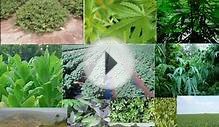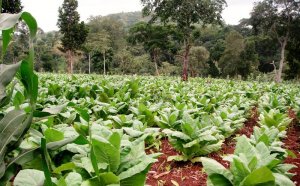
Cash crop history
 The farming methods employed differ from farmer to farmer and from country to country. In developing countries, many traditional farmers continue to adopt their customary practices. But in highly industrialized countries, intensive cultivation and mechanized farming are common. This is so with large plantations operated by multinational companies and by individuals having sufficient capital.
The farming methods employed differ from farmer to farmer and from country to country. In developing countries, many traditional farmers continue to adopt their customary practices. But in highly industrialized countries, intensive cultivation and mechanized farming are common. This is so with large plantations operated by multinational companies and by individuals having sufficient capital.
Monocropping or sole cropping, which is the growing of a single crop on a piece of land, is common with cash crop farming while subsistence farming usually practices multiple cropping or mixed cropping. In contrast to the aim of cash cropping, subsistence farming is practiced for sustenance, that is, for the food of the farmer and his family. Subsistence crops are also grown for feed of the farmer’s livetock including working animals.
While there are many advantages to cash crop farming such as source of living for the farmer, salaries and wages for the employees and farm workers, and government revenue through taxes, it may also have adverse effects.
As a result of monocropping, which is commonly practiced in growing cash crops in plantation scale, the production of certain food crops may become limited. Continuous monocropping is likewise associated with soil degradation and proliferation of insect pests and disease pathogens.
An example is that of potato. Following its introduction, it became the staple crop of Ireland. In 1845-1846, the crop was devastated by a serious disease which resulted to mass starvation.
Exportation, if not regulated, may likewise result to short supply but high prices of locally available food. It is known, however, that exportation is always regulated.
When cash cropping started cannot be established with certainty. It’s historical evolution can only be deducted using logic as related to the history of agriculture and civilization.
Before the advent of agriculture, the primitive man obtained food by hunting wild animals and gathering fruits and nuts from natural stands. .
 But the discovery that certain plants can be grown from seeds caused a gradual transformation from hunting-gathering to farming. The primitive man began to domesticate plants and so there was no longer any reason for him to maintain his nomadic way of life in search of food.
But the discovery that certain plants can be grown from seeds caused a gradual transformation from hunting-gathering to farming. The primitive man began to domesticate plants and so there was no longer any reason for him to maintain his nomadic way of life in search of food.
Groups of men lived in villages, and soon the populace was divided into two groups: urban and rural. The urban people engaged in the processing and trading of the raw materials which the rural people supply. This gave rise to the modern civilization which is characterized by an advanced agricultural technology, long-distance marketing, and occupational specialization among the populace.
This must be how cash crop farming evolved.
Based on archaelogical records, farming or agriculture started at least 10, 000 years ago. The when and where are continuously debated. However, the credit for the first civilization to be established goes to the Sumerians.
By 5000 BC the Sumerians had developed special agricultural techniques including intensive crop farming in large-scale, monocropping, organized irrigation, and the use of labor with specialized skills. They invented the plow.
They grew barley, chickpeas, lentils, wheat, dates, onions, garlic, lettuce, leeks and mustard. They also raised cattle, sheep, goats, and pigs. They used oxen as their primary draft animal and donkeys or equids for transport.
Archaeological artifacts indicate that they were engaged in trading with neighboring regions centered around the Persian Gulf.
The land of the Sumer is located in what is now called Fertile Crescent. It lies between two great rivers, the Euphrates and Tigris. Modern-day countries within the Fertile Crescent are Iraq, Jordan, Lebanon, Syria, Israel and parts of the Palestinian Territories, besides Turkey and Iran.
VIDEO REVIEWS


Share this Post
Related posts
Tobacco, Cash Crop
The year was 1614, and the sailing ship Elizabeth was setting off from the young English colony of Jamestown, bound for London…
Read MoreTobacco history facts
Nicotine was isolated from tobacco leaves ( Nicotiana tabacum ) in 1828, but the powerful effects of nicotine were already…
Read More










